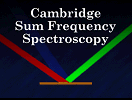|
|
|
Navigation Links |
||
| Home Page |
||
| Latest News |
||
| Group Members |
||
| Research Interests |
||
| Collaborations |
||
| Publications |
||
| Conferences |
||
| Contact Details |
||
| Gallery |
||
| Links |
||
Research InterestsSpectroscopy of Transient Phosphorus Molecules
|

|
|
Summary of Interests |
|
Phosphorus in its white elemental form reacts spontaneously with air to produce an intense white-green chemiluminescent glow. The oxidation proceeds via a complex chain reaction which has been the subject of many studies since the isolation of phosphorus in 1669. The identity of the emitting species has been the subject of considerable controversy, but is now known to be an excited electronic state of the PO2 radical. In Cambridge, we have used infra-red diode laser absorption spectroscopy to directly probe the transient species generated by the chemiluminescent reaction between oxygen atoms and P4 vapour. The short-lived molecules are produced in a fast flow system incorporated in a multiple pass White cell, with absorption pathlengths of up to 40m. By carefully controlling the reaction conditions, new infra-red spectra of PO, PO2 and P2O have been detected. The complexity of the oxidation chain reaction opens the door to a range of novel species. Recently, we have observed the PNO molecule for the first time in the gas phase by addition of NO to the chemiluminescent region. This molecule is found to have a linear structure, analogous to its counterparts P2O and N2O. Currently, we are exploring novel species formed when Cl2 is added to the reacting gas region, in particular the OPCl molecule.  |
|
| Return to Top of Page | |